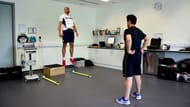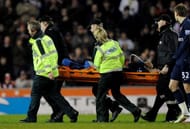Aaron Ramsey, Eduardo da Silva, Luke Shaw, Demba ba- do these names ring a bell?
All of them have been subjected to gory tackles and suffered horrific injuries in recent times while playing the beautiful game.
Injuries are an integral aspect of the game of football. Goals may be hard to come by, but an injury is the most commonplace – an unfortunate epidemic to plague the sport. With the advent of medicine, players tend to recuperate much faster now than earlier. However, the threat of a niggle is perilously close throughout the life of a football player.
Initial trauma
From the loud ranging thud to that awkward twitching, injuries can be far and fearsome. Sometimes, the player just calls off holding his leg while others are just sent sprawling across the floor after a gruesome tackle.
Whatever it may be, the initial shock is often difficult to bear. The first thought that comes with sharp shooting pain is whether the ability to walk would be compromised. If that is hindered, the normal life of the individual goes for a toss.
Also Read: 5 players whose careers were destroyed due to injuries
Prognosis and diagnosis
The team doctor sheds some light on the likely injury as the player gets carried off for the tests. It is only after the latter have been done, the extent of the injury gets confirmed. With that, the medical course takes shape and the player zones out from the field to the four walls of his confinement.
If it is a serious injury, the rest phase can continue for upto many weeks. The post operation phase is generally the toughest to bear with. The movement gets restricted, the thoughts get disarrayed and all of a sudden, life seems difficult.
Coupled with the images of that gruelling tackle and the prickly pain afterwards, it gets harrowing to come to terms with the new ‘normal’.
Recuperation and training
The phase when you can start walking and are advised to join the gym- that is the closest you can get to the pre-injury life. The mind ventures to the football pitch but the body refuses to cooperate.
That can be the most difficult phase of the post-injury life of a footballer. The constant war raging within often destabilises the framework and only a handful of players reach their peak after such an injury.
It is a different setup when the player stays at home. The familiar faces of the training ground, the familiar feel of the football at his feet- these sort of niceties are excluded from the life at home. The family is there to support him, but his true strength lies when the ball is at his feet.
Weak moments haunt him and the ominous threat of not playing the beautiful game ever again looms large. Words of support from the football fraternity do their bit in boosting the sagging morale. When the coach comes by the side of the player, it somewhat eases out the dicey situation.
To play or not to play

With a team of dedicated medical attendants, getting the player match ready is the last hurdle of the recuperation process. He starts with the conditioning and strengthening process, before hitting the football drills.
This is the time when the days seem brighter and renews the player’s hope to get back to the field. Constant medical supervision is the call of the hour to ensure there isn’t any slip up in the process.
Taxing times like these test the strongest of the individuals. He who keeps his chin up without muddling up his thoughts emerges the fittest. It is not easy to see yourself in the mirror and not know what your future is going to be.
For a professional footballer, it is the game that earns him his bread. Without it, things will not be the same for the individual. Thus, the quicker he recovers, the better are the chances to get back to action.
An example at hand would be Colombian striker, Radamel Falcao. Now at 31, El Tigre has scored 24 goals across all competitions this season for his current side AS Monaco. After recovering from his long-standing knee injury, the Colombian had forgettable loan spells with Manchester United and Chelsea. But he has buried those seasons and now has hit top form for the Ligue 1 side.
Examples like these give hope to the injury-hit, bed-ridden footballer. He can hope for better days on the anvil when he dons the boots and gets back to the pitch, shedding all the inhibitions.
Life of a footballer is certainly not as rosy as it seems through the lens of the social media. With hiccups like these, it is only the robust who survives the ordeal unflinchingly.

